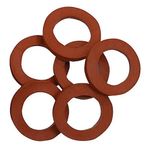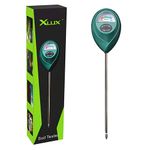
Astilbe, translated from Greek, means “without brilliance.” Maybe the wild astilbes that earned this dismissive genus name were drab, but today’s cultivars offer bright flowers, great foliage, and steadfast performance in moist, shady locations.
Tiny, frothy flowers come in shades of red, white, pink, and violet, and open from the bottom up on plumelike panicles. Bloom time is typically two to four weeks. Most astilbes have fine-textured foliage that looks great even after the flowers fade.
Astilbes can’t tolerate drought, alkaline soil, or extreme heat, so there are regions where they don’t grow well. Varieties with A. chinensis heritage have more sun, heat, and drought tolerance. Like all astilbes, though, they need fertile soil and adequate water to truly thrive.
To learn more about this diverse and widely hybridized genus, we asked experts with astilbe growing experience to recommend some favorite varieties and share cultural tips.
Our Experts:
Valerie Hawkins spent her career in horticulture as a business owner, grower, and propagator. She now spends her leisure time on gardening, her true passion.
Jeremy Windemuller is trial manager at Walters Gardens and owner of Windridge Perennials and Landscaping in Zeeland, Michigan.
George and Gail Africa own Vermont Flower Farm, a retail nursery in Marshfield, Vermont. They have grown and sold dozens of astilbe varieties over the years.
Valerie’s Picks:
1. ‘Hennie Graafland’ is a Delight, with Wispy, Slightly Nodding Plumes
A. simplicifolia ‘Hennie Graafland’

The foliage is a glossy, rich dark green, and remains tight and attractive after bloom. ‘Hennie’ thrives in light shade, perfect in a mass or as a single specimen toward the front of a planting. First introduced as an alternative to the highly popular ‘Sprite’ (A. simplicifolia ‘Sprite’, USDA Hardiness Zones 4–8), ‘Hennie’ is a much more vigorous grower with very few pest or disease problems.
Zones: 4 to 8
Bloom: pale pink
Foliage: Dark green
2. ‘Montgomery’ is an Old-Time Favorite and Still One of the Best Red Astilbes

A. japonica ‘Montgomery’
With true-red plumes, red stems, and even a tint of red at the tips of the leaves, ‘Montgomery’ adds dramatic color in heavy shade. The plumes emerge midseason, upright and held well above the foliage. Seen from a distance, a mass planting of ‘Montgomery’ in full bloom is spectacular.
Zones: 4 to 8
Bloom: Magenta-red
Foliage: Emerges bronze-red, maturing to deep green
3. ‘Perkeo’ is a Whimsical Dwarf Variety with Upright, Rose-Pink Plumes
A. crispa ‘Perkeo’

The crinkly, dark green foliage has a very dense, compact habit. This gem could be used in a shaded rock garden, a container, or tucked in next to a shady path. With regular moisture, ‘Perkeo’ can take some sun, especially in regions with cooler summers.
Zones: 4 to 8
Bloom: Deep pink
Foliage: New leaves are reddish, quickly transitioning to deep green.
4. ‘Chocolate Shogun’ Offers a Hot, New Leaf Color
A. ‘Chocolate Shogun’

Traditionally there has been little variability in astilbes’ foliage, which generally ranges from light to dark green, sometimes with hints of red or bronze. ‘Chocolate Shogun’ is the result of new breeding that brings true, rich, chocolate-maroon foliage into the mix. What a welcome addition. Be sure to give this astilbe enough sunlight to keep that great color, as deep shade will cause the leaves to turn a muddy dark green. The midseason blooms are pale pink and not very showy, but it’s worth growing this one just for the foliage.
Zones: 4 to 8
Bloom: White tinged with pink
Foliage: Deepest, darkest foliage of any astilbe
Jeremy’s Picks:
5. ‘Purple Candles’ has Dense, Pokerlike Plumes that Add a Unique Look to the Shade
A. chinensis ‘Purple Candles’ (‘Purpurkerze’)

Its flowers emerge violet-red, becoming paler with age in midsummer. This is a big, back-of-the-border astilbe, with coarse, dark green foliage. Its statuesque spires make a statement in the shade, and its A. chinensis genes give it more sun and heat tolerance than many other varieties.
Zones: 4 to 8
Bloom: Dark violet-red softening to paler purple
Foliage: Dark green leaves, sometimes bronze
6. ‘Delft Lace’ is a Vigorous Grower

A. ‘Delft Lace’
Its attractive, deep red stems are topped with soft apricot-pink flowers in early summer, followed by long-lasting red seed heads. With waxy, blue-green foliage that takes on a slight burgundy glow in autumn, ‘Delft Lace’ looks great throughout the growing season.
Zones: 4 to 8
Bloom: Soft apricot-pink on deep red stems
Foliage: Glossy blue-green with red highlights
7. ‘Visions’ is My Favorite Compact Selection
A. chinensis ‘Visions’

This vigorous variety seems to have taken the landscape industry by storm because it is a very reliable grower. ‘Visions’ is covered with short, slightly fragrant plumes in midsummer. The foliage is coarse and dense with large, clear green leaves.
Zones: 4 to 8
Bloom: Raspberry pink
Foliage: Medium green
8. ‘Amber Moon’ Glows in the Spring Shade Garden
A. Chinensis ‘Amber Moon’


Emerging with chartreuse-yellow foliage edged with red that transitions to a bright green as the season progresses. This taller, strong-stemmed variety sends up spires of rose-pink flowers in midsummer, performing well even in summer heat. For best leaf color, give ‘Amber Moon’ a good balance between sun and shade. A little sun, especially morning sun with afternoon shade, will result in a brighter leaf color, but too much sun will burn the leaves.
Zones: 4 to 8
Bloom: Medium pink
Foliage: Green-yellow edged with red in spring, deepening to chartreuse
George’s and Gail’s Picks:
9. We Love ‘Rock and Roll’ for its Red Stems with Very Thick White Plumes
A. arendsii ‘Rock and Roll’

Most “white” astilbes are more cream-colored, but this cultivar is a true white. With a compact growth habit and many blooms, this selection will lend star power to the front of any shady border. Try planting ‘Rock and Roll’ with at least one companion that plays up its contrasting stems.
Zones: 4 to 8
Bloom: Pure white blooms on reddish stems
Foliage: Deep green
10. ‘Mighty Pip’ is an impressively tall, rugged, and late bloomer
A. chinensis ‘Mighty Pip’

It will take about three years for this A. chinensis hybrid to reach its full potential, with soft, rose-colored plumes on red stems reaching 4 feet tall or higher. Create pollinator heaven by combining it with Grand Marshall™ bee balm (Monarda didyma ‘AChall’, Zones 3–8) and a dark-leaved bugbane (Actaea simplex Atropurpurea Group, Zones 5–8).
Zones: 3 to 7
Bloom: Soft pink flowers on red stems
Foliage: Glossy, deep green
11. ‘Glow’ offers wispy, elongated red blooms and abundant, bronze-green foliage

A. arendsii ‘Glow’ (aka ‘Glut’)
It stands straight and full, topping out at around 30 inches. Needing only a bit of dappled sun to look its best, ‘Glow’ is a midseason bloomer that will add intense color and reliably attractive foliage in shady locations. Like many midsized astilbes, this enduring favorite from the arendsii group can serve as a lovely, fine-textured ground cover before and after its blooms peak.
Zones: 4 to 8
Bloom: Deep red with rose highlights
Foliage: Bronze-red, maturing to medium green
12. Vibrantly colored ‘Rise and Shine’ is a new cultivar with a definite wow factor

A. ‘Rise and Shine’
It has hot pink plumes; dense, attractive foliage; and a sturdy root system. It offers better heat and drought tolerance than many other cultivars, due to its A. chinensis heritage. In our central Vermont display garden, we grow it in full sun in moist, well-amended soil. In warmer climates, make sure it has afternoon shade and mulch to keep the soil cooler.
Zones: 3 to 8
Bloom: Hot pink
Foliage: Coarse, medium green
Spacing and Placement
Astilbes range in size from adorable dwarf varieties to statuesque beauties. Here’s how they measure up.

‘Perkeo’ Size: 6 to 8 inches tall and wide Height in bloom: 8 to 10 inches |

‘Hennie Graafland’ Size: 16 to 18 inches tall and 10 to 14 inches wide Height in bloom: 20 to 22 inches |

‘Montgomery’ Size: 18 to 20 inches tall and wide Height in bloom: 24 inches |

‘Chocolate Shotgun’ Size: 12 to 18 inches tall and wide Height in bloom: 20 to 24 inches |

‘Purple candles’ Size: 24 inches tall and 18 to 24 inches wide Height in bloom: 42 inches |

‘Visions’ Size: 9 to 12 inches tall and wide Height in bloom: 14 to 18 inches |

‘Delft Lace’ Size: 18 to 24 inches tall and wide Height in bloom: 36 inches |

‘Amber Moon’ Size: 24 to 30 inches tall and 20 to 24 wide Height in bloom: Up to 38 inches |

‘Mighty Pip’ Size: 40 to 48 inches tall and 36 to 48 inches wide Height in bloom: 48 inches |

‘Purple candles’ Size: 12 to 18 inches tall and wide Height in bloom: 24 to 28 inches |

‘Purple candles’ Size: 16 to 20 inches tall and 12 to 16 inches wide Height in bloom: 24 inches |

‘Purple candles’ Size: 18 to 24 inches tall and wide Height in bloom: 30 inches |
At a Glance

▸ Moist soil is a must. Astilbes’ roots should never be allowed to dry out completely. They need consistently moist, fertile soil, and suffer in drought.
▸ Crispy leaf margins are a cry for help. Respond to this urgent sign of drought stress by rehydrating the root system and watering regularly as long as dry weather persists.
▸ Strike the right balance between sun and shade. Most astilbes prefer partial shade. Deep shade will decrease bloom performance, but most varieties will suffer in too much sun. Try a location with dappled shade or morning sun. Some A. chinensis hybrids will happily grow in full sun, as long as they have sufficient moisture.
▸ Arendsiis are a safe bet. In the early 20th century, gifted German nurseryman George Arends combined the genetics of A. chinensis, A. japonica, A. thunbergii, and A. astilboides to create many outstanding hybrids that have stood the test of time.
Photos and drawings, except where noted: Carol Collins
Sources:
- American Meadows, Shelburne, VT; 877-309-7333; americanmeadows.com
- Bluestone Perennials, Madison, OH; 800-852-5243; bluestoneperennials.com
- Perennial Farm Marketplace, Baldwin, MD; 888-987-8044; perennialfarmmarketplace.com
- Vermont Flower Farm, Marshfield, VT; 802-426-3505; vermontflowerfarm.com
Fine Gardening Recommended Products

Gilmore Rubber Hose Washer 10pk

XLUX Soil Moisture Meter

RAINPOINT Sprinkler Timer with Brass Swivel

















Comments
Log in or create an account to post a comment.
Sign up Log in